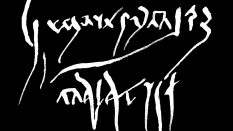Immolation - Here in After
 This month marks the 20th year of Immolation’s existence. I saw them play last night alongside Averse Sefira, Belphegor, and Rotting Christ. My expectations were high, and the band far exceeded them. Like many, I’ve burned out on death metal in the last few years – or maybe it’s burned out. But recent strong shows (and records) by Decrepit Birth and Hate Eternal, and now Immolation, have convinced me death metal’s not dead yet.
This month marks the 20th year of Immolation’s existence. I saw them play last night alongside Averse Sefira, Belphegor, and Rotting Christ. My expectations were high, and the band far exceeded them. Like many, I’ve burned out on death metal in the last few years – or maybe it’s burned out. But recent strong shows (and records) by Decrepit Birth and Hate Eternal, and now Immolation, have convinced me death metal’s not dead yet.
Ironically, such life comes from the old school. Bands like Cannibal Corpse and Suffocation weren’t influenced by death metal because they were inventing it. Thus, early Cannibal Corpse was like early Kreator revved up, and Suffocation incorporated all kinds of “-core” long before “deathcore” was a last.fm tag. They were unique, a quality sorely lacking in today’s bands. The whole goregrind subgenre is pointless when there’s already Carcass and Cannibal Corpse. Given parity in execution, innovation trumps imitation.
Last night’s show reinforced the uniqueness of Immolation. Their sound is recognizable almost instantly, which isn’t even true for, say, Cannibal Corpse or Deicide. The key is guitarist Robert Vigna, who should have ranked much higher on Decibel‘s Top 20 Death Metal Guitarists. As an idiosyncratic stylist, he’s Trey Azagthoth’s equal. His pinch harmonics and nagging bends give Immolation an atmosphere usually found only in black metal; Hate Eternal’s Erik Rutan has also mined such territory in recent years.
 |
Vigna’s live performance adds another dimension to his sound. Normally, I’m skeptical of axe-waving guitarists; I have seen bands do incredibly lame choreographed guitar-waving. But Vigna’s punctuating spaces and physically embodying his riffs. He does something I’ve never seen anyone else do – claw out chords with upstrokes, even on lower strings. He looks like he’s ripping notes out of his guitar. This is probably for show, but what a show it is. His pick hand flies one way, and his fretting hand the other way; he carves shapes in the air like an orchestral conductor. It’s thrilling to watch – see this short YouTube clip, as well as this one.
Many cite 1991’s Dawn of Possession as their favorite Immolation record. It’s good, the archetypal feral debut. But Immolation didn’t sound like Immolation until 1996’s Here in After. The record brought out pinch harmonics and nagging bends in full force; check out the groaning riffs at 0:13 in “Burn with Jesus” and the intro to “Here in After.” At this point, Immolation still packed too many riffs into songs – later streamlining would arguably culminate in the monolithic Harnessing Ruin – but they were undeniably fresh and hungry. Today’s robotic Necrophagist acolytes would do well to take note.











